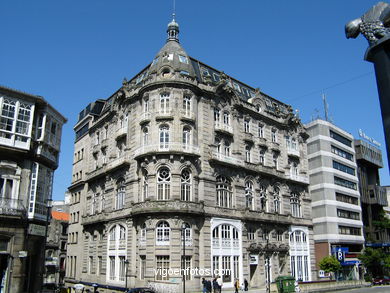Total eclecticism (1880-1910)
Vigo: Total eclecticism (1880-1910)
In this period, between 1880-1910, the rich bourgeoisie Vigo is suing eclectic language sumptuous buildings, which will be known by the name of its owner, even many of them carrying the owner's initials inscribed on granite crowning elements of the facades as a symbol of prestige.
Eclecticism showing Sesmero Alexander and Domingo Rodriguez, is becoming more complex and elaborate work of these technicians, greatly increasing the variety of ornamental components and interpretive freedom.
With the presence of the Source Jenaro Dominguez and Michel consolidates Pacewicz Vigo international eclecticism of French influence.
The influence exerted teste Paris was remarkable period in Spanish architecture of this period, clearly demonstrating this attraction also in the local bourgeoisie. The presence in Vigo's French coach Michel Pacewicz introduces a Frenchified eclecticism in the expansion of the city. This eclecticism, met the needs of the local upper classes in their desire of distinction and social differentiation.
The architecture of this period is characterized by a great concern for the submission and processing of the facades, to the detriment of less concern for the interior layout of the plants that could present problems of ventilation and hygiene.
It shall give preference to the facades is that place in the main streets in the same increasing ornamentation.
Proliferate at this time cast galleries that reach widespread from the 1870s, reaching joining buildings were designed without him.
Fulfilling the role of viewpoint and new compositional element in the design of the facades. The window and door joinery is refined in this era, where local artisans make the cut based on the design of the facade.
In this period, the late nineteenth and early twentieth centuries, historicist influences are the works of Jenaro de la Fuente, Michel Pacewicz, Manuel Felipe Quintana and Benito Gómez Román. The variety of languages ??will be an inspiration for the architect who moves freely in the historicism and eclecticism classicist.
Source Jenaro Dominguez shows more concern for decoration, presented a repetitive pattern and traditional composition. Their facades are characterized by a symmetrical arrangement with lack of movement that is offset by a high job security ornamental repertoire.
Michel Pacewicz, lulled by the great French architect, demonstrate a greater capacity and a lower desire compositional decorative facades presented their dynamism and pace.However Pacewicz showed no evolution towards modernism, unlike Jenaro of Source that collects in his modernist vocabulary items.
Architects and master builders representative
- Source Jenaro Domínguez
- Michel Pacewicz
- Manuel Felipe Quintana
Representative buildings
- Casas de Oya - Miguel Pacewicz (1904)
- Building The Modern - Miguel Pacewicz (1897)
- Building Bonin - Source Jenaro Domínguez (1910)
- Homes Bárcena Manuel Franco - James Estens Romero (1879)
.